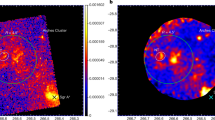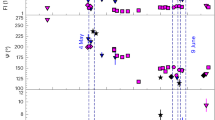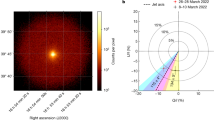Abstract
It is widely accepted that strong and variable radiation detected over all accessible energy bands in a number of active galaxies arises from a relativistic, Doppler-boosted jet pointing close to our line of sight1. The size of the emitting zone and the location of this region relative to the central supermassive black hole are, however, poorly known, with estimates ranging from light-hours to a light-year or more. Here we report the coincidence of a gamma (γ)-ray flare with a dramatic change of optical polarization angle. This provides evidence for co-spatiality of optical and γ-ray emission regions and indicates a highly ordered jet magnetic field. The results also require a non-axisymmetric structure of the emission zone, implying a curved trajectory for the emitting material within the jet, with the dissipation region located at a considerable distance from the black hole, at about 105 gravitational radii.
This is a preview of subscription content, access via your institution
Access options
Subscribe to this journal
Receive 51 print issues and online access
$199.00 per year
only $3.90 per issue
Buy this article
- Purchase on Springer Link
- Instant access to full article PDF
Prices may be subject to local taxes which are calculated during checkout


Similar content being viewed by others
References
Ulrich, M.-H., Maraschi, L. & Urry, C. M. Variability of active galactic nuclei. Annu. Rev. Astron. Astrophys. 35, 445–502 (1997)
Hartman, R. C. et al. Detection of high-energy gamma radiation from quasar 3C 279 by the EGRET telescope on the Compton Gamma Ray Observatory. Astrophys. J. 385, L1–L4 (1992)
Kniffen, D. A. et al. Time variability in the gamma-ray emission of 3C 279. Astrophys. J. 411, 133–136 (1994)
Wehrle, A. E. et al. Multiwavelength observations of a dramatic high-energy flare in the blazar 3C 279. Astrophys. J. 497, 178–187 (1998)
Albert, J. et al. Very-high-energy gamma-rays from a distant quasar: how transparent is the Universe? Science 320, 1752–1754 (2008)
Nilsson, K. et al. The host galaxy of 3C 279. Astron. Astrophys. 505, 601–604 (2009)
Woo, J.-H. & Urry, C. M. Active galactic nucleus black hole masses and bolometric luminosities. Astrophys. J. 579, 530–544 (2002)
Jorstad, S. G. et al. Polarimetric observations of 15 active galactic nuclei at high frequencies: jet kinematics from bimonthly monitoring with the Very Long Baseline Array. Astron. J. 130, 1418–1465 (2005)
Larionov, V. M. et al. Results of WEBT, VLBA and RXTE Monitoring of 3C 279 during 2006–2007. Astron. Astrophys. 492, 389–400 (2008)
Laing, R. A. A model for the magnetic-field structure in extended radio sources. Mon. Not. R. Astron. Soc. 193, 439–449 (1980)
Atwood, W. B. et al. The Large Area Telescope on the Fermi Gamma-Ray Space Telescope Mission. Astrophys. J. 697, 1071–1102 (2009)
Marscher, A. P. et al. The inner jet of an active galactic nucleus as revealed by a radio-to-gamma-ray outburst. Nature 452, 966–969 (2008)
Sikora, M., Begelman, M. C. & Rees, M. J. Comptonization of diffuse ambient radiation by a relativistic jet: the source of gamma-rays from blazars? Astrophys. J. 421, 153–162 (1994)
Konigl, A. & Choudhuri, A. R. A model of the polarization position-angle swings in BL Lacertae objects. Astrophys. J. 289, 188–192 (1985)
Homan, D. C. et al. PKS 1510–089: a head-on view of a relativistic jet. Astrophys. J. 580, 742–748 (2002)
Lyutikov, M., Pariev, V. I. & Blandford, R. Polarization of prompt gamma-ray burst emission: evidence for electromagnetically dominated outflow. Astrophys. J. 597, 998–1009 (2003)
Sikora, M., Stawarz, L., Moderski, R., Nalewajko, K. & Madejski, G. Constraining emission models of luminous blazar sources. Astrophys. J. 704, 38–50 (2009)
Netzer, H. et al. The optical-ultraviolet-gamma-ray spectrum of 3C279. Astrophys. J. 430, 191–195 (1994)
Pian, E. et al. Ultraviolet and multiwavelength variability of the blazar 3C 279: evidence for thermal emission. Astrophys. J. 521, 112–120 (1999)
Dermer, C., Schlickheiser, R. & Mastichiadis, A. Gamma-rays from extragalactic radio sources. Astron. Astrophys. 256, L27–L30 (1992)
Blandford, R. D. & Levinson, A. Pair cascades in extragalactic jets: 1: Gamma-rays. Astrophys. J. 441, 79–95 (1995)
Abdo, A. A. et al. Early Fermi Gamma-ray Space Telescope observations of the quasar 3C 454.3. Astrophys. J. 699, 817–823 (2009)
Villata, M. et al. The correlated optical and radio variability of BL Lacertae. WEBT data analysis 1994–2005. Astron. Astrophys. 501, 455–460 (2009)
Watanabe, M. et al. TRISPEC: a simultaneous optical and near-infrared imager, spectrograph, and polarimeter. Publ. Astron. Soc. Pacif. 117, 870–884 (2005)
Fuhrmann, L., Zensus, J. A., Krichbaum, T. P., Angelakis, E. & Readhead, A. C. S. Simultaneous radio to (sub-) mm-monitoring of variability and spectral shape evolution of potential GLAST blazars. AIP Conf. Proc. (1st GLAST Symp.) 921 249–251 (2007)
Acknowledgements
Acknowledgements The Fermi-LAT Collaboration acknowledges support from a number of agencies and institutes for both development and the operation of the LAT as well as scientific data analysis. These include NASA and DOE in the United States, CEA/Irfu and IN2P3/CNRS in France, ASI and INFN in Italy, MEXT, KEK and JAXA in Japan, and the K. A. Wallenberg Foundation, the Swedish Research Council and the National Space Board in Sweden. Additional support from INAF in Italy for science analysis during the operations phase is also gratefully acknowledged. The GASP-WEBT observatories participating in this work are Abastumani, Calar Alto, Campo Imperatore, Crimean, Kitt Peak (MDM), L'Ampolla, Lowell (Perkins-PRISM), Lulin, Roque de los Muchachos (KVA and Liverpool), San Pedro Mártir, St Petersburg for the optical–NIR bands, and Mauna Kea (SMA), Medicina, Metsahovi, Noto and UMRAO for the millimetre radio band, and are supported in part by the Georgian National Science Foundation, the Spanish “Ministerio de Ciencia e Innovación”, the NSF and NASA and the Smithsonian Institution in the United States, the UK Science and Technology Facilities Council, the Academia Sinica in Taiwan, the Russian RFBR and the Academy of Finland. M.H. is supported by the JSPS for the Postdoctoral Fellowship for Research Abroad. J. Conrad is a Royal Swedish Academy of Sciences Research Fellow, funded by a grant from the K. A. Wallenberg Foundation. L.T. is partially supported by the International Doctorate on Astroparticle Physics (IDAPP) programme.
Author Contributions All authors contributed to the work presented in this paper. M. Uemura and R. Itoh led the Kanata observations and data analysis. M. Villata organized the optical-radio observations by GASP-WEBT as the president of the collaboration.
Author information
Authors and Affiliations
Consortia
Corresponding authors
Ethics declarations
Competing interests
The author declare no competing financial interests.
Additional information
Lists of participants and their affiliations appear at the end of the paper.
PowerPoint slides
Rights and permissions
About this article
Cite this article
The Fermi-LAT Collaboration and members of the 3C 279 multi-band campaign. A change in the optical polarization associated with a γ-ray flare in the blazar 3C 279. Nature 463, 919–923 (2010). https://doi.org/10.1038/nature08841
Received:
Accepted:
Issue Date:
DOI: https://doi.org/10.1038/nature08841
This article is cited by
-
Understanding the giant gamma-ray outburst on June 16, 2015 from the blazar 3C 279
Astrophysics and Space Science (2020)
-
Polarization and QPOs from jets in black hole systems
Journal of Astrophysics and Astronomy (2018)
-
Blazar spectral variability as explained by a twisted inhomogeneous jet
Nature (2017)
-
Central engine of a gamma-ray blazar resolved through the magnifying glass of gravitational microlensing
Nature Physics (2015)
-
Effect of a partial coverage of quasar broad-line regions by intervening H 2 $\mbox{H}_{2}$ -bearing clouds
Astrophysics and Space Science (2015)
Comments
By submitting a comment you agree to abide by our Terms and Community Guidelines. If you find something abusive or that does not comply with our terms or guidelines please flag it as inappropriate.



